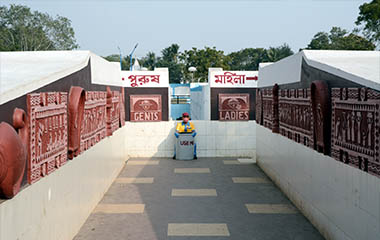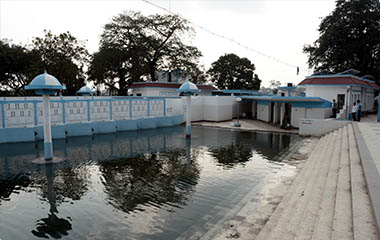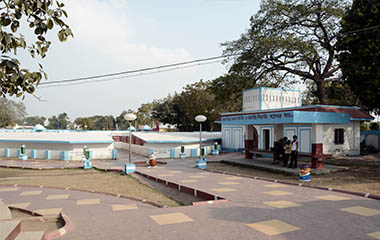Introduction
Bakreswar Development Authority was constituted vide notification no. 939-T&CP /C-2/1P-05/2016 , dated 1st June 2016 by sub-division of Bakreswar Planning Area (original) of Bakreswar Planning Authority and inclusion of sub-divided area in Bakreswar Planning Area (revised) of Bakreswar Development Authority vide sub-section (3) of section 9 of the West Bengal, T&CP (P&D) Act, 1979 .
Bakreswar Development Authority was constituted by comprising 26 nos of mouzas of Gohaliara GP (full) under Dubrajpur block ;5 nos of mouzas of Laxminarayanpur GP (full) under Dubrajpur block II ;2 nos of mouzas of Hetempur GP (part) whose area has been included in Municipality ; 9 nos of mouzas of Dubrajpur municipality (part),to maintain geographical contiguity .The total area covered is 57.94 sq km. The town of Bakreswar is one of the fastest growing tourist spots in West Bengal .
Bakreswar is a town located 23.88°N 87.37°E in the 18 kms South West of Suri, the district headquarter of Birbhum district in the state of West Bengal. The name Bakreswar is a compound of two words 'bakra' meaning "curve” or "deformity," and ‘ishwar 'meaning "lord”. Mythologically it is said that in Satya Yuga during the marriage ceremony of Lakshmi and Narayan, Astabakra Muni (then known as Subrata Muni) was insulted by Indra. The muni was so enraged that he developed 8 cripples in his body (Ashtabakra Muni means a sage with 8 curved cripples, probably kyphoscoliotic). Ashtabakra ("eight curves") Muni, intensely meditated upon Lord Shiva for 10,000 years. Profoundly moved by this ardent display of penance, Lord Shiva not only cured his beloved devotee of physical deformity, but further declared that those who visited Bakreswar and venerated Ashtabakra before him would be graced with a surplus of boons. Corresponding with this myth, there are two lingams housed within the Shiva temple. The larger lingam is referred to as Ashtabakra, and the smaller one is called Bakreswar. Although specified with different names, both of these lingams are perceived as physical manifestations of Lord Shiva which, by extension, function as conduits of spiritual power through which the god can be communed.
Bakreswar is also famous as one of the 51 Shakti Pithas where there is a temple dedicated to Adi Shakti. This is a major pilgrimage spot for Hindus. As a shakti pith, the Mahishamardini Mandir draws worshipers of the divine mother to this country town, named for its resident male god. At the heart of Bakreswar, the spiritual traditions of Shiva and Shakti converge, reconciling the dichotomy of masculine and feminine divinity in one harmonious temple complex. Historically a focal point of religious pilgrimage, the majority of Hindus traveling to Bakreswar come for its famous Shiva Mandir. Although the presence of a shakti pith and its corresponding mandir (Hindu temple] technically make Bakreswar a two-temple complex, the veneration of Lord Shiva observably assumes a position of elevated prominence.
Bakreswar is also a place of geological interest with many hot springs along with a number of cold springs ultimately forming a tributary. There are ten hot springs here. They are - Paphara ganga, Baitarini ganga, Khar kunda (the water is of 66° C), Bhairav kunda (the water is of 65° C), Agni kunda (the water is at 80 0 C. It is also rich in many minerals of sodium, potassium, calcium, silicates, chlorides, bicarbonates and sulphates which are said to have medicinal properties. It might also contain traces of radioactive elements.), Dudh kunda (the water of this spring attains a dull white hue during early morning probably due to ozone concentration. The water in this spring is at 66 0 C.), Surya kunda (Surya means sun. The water in this spring is of 61° C), Shwet ganga, Brahma kunda and Amrita kunda. These hot springs are known to cure a number of chronic diseases and thus are appealing to a huge number of devotees.
Bakreswar River flows past the town. A big Mela is held every year on the day of Shiva- Ratri wherein huge numbers of devotees gather to attain divine pursuit. Bakreswar is famous for a group of sulphurous springs, known as the Bakreswar Group of Springs which are situated on the right bank of the Bakreswar stream, 1.6 km. south of Tantipara village. The approach to this area is by a 12 km. metalled road from Suri, the nearest town. Emergence of hot water and gases is noticed here at seven different spots aligned northeast-southwest, which probably is a granite genies fissure.
The two important springs in this group are Agni Kunda and Brahma Kunda. The hot springs are regarded as a manifestation of divine power, and are frequented by barren women and women suffering from miscarriage. The hot spring waters are cure for diseases like bronchitis, phthisis, diabetes, and nearly every description of skin diseases.
Each hot spring is enclosed in a cistern 10 feet in depth and of dimensions ranging from a square of 9 feet to a rectangle of 75 by 30 feet. The name of the springs are Agni Kunda, Brahma Kunda, Setganga, Surya Kunda, Jiban Kunda, Bhairab Kunda, Saubhagya Kunda and Khar Kunda. The Government of West Bengal has developed this place as a tourist centre. Now the bathers are not allowed to descent to the holy waters of the cisterns; instead they are supplied piped water.
The place is renowned for historical importance as holy place for the existence of “Shiva Lingam”. A big Mela is held every year on the day of Shiva Ratri. The hot springs with cold springs are in close proximity to the temple. They all discharge in to a rivulet which run past and join a small stream about 200 yards from the temple.




